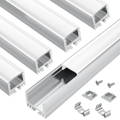Table of Contents
Introduction
LED Strip Lights are amazing products for dynamic design solutions allowing for customizable lighting solutions in different settings. However, through time exposed LED strips may tarnish and affect the look of the overall environment. This is where concealing comes in. Hidden efficiently, the strips change a room completely: Light blends into the design. This guide will teach you all about concealing LED strip lights-read techniques, tools, and best practices so that you can achieve professional result.
Why Hide LED Strip Lights?
Planning Your LED Strip Light Installation
Materials and Tools You'll Need
Hiding LED Strip Lights: Techniques and Tricks
- Aluminum Channels/Profiles: These offer a clean and professional way to hide LED strips while also providing heat dissipation. They come in various shapes and sizes, including surface mount, recessed, and corner mount options.
- Recessed Lighting with Drywall: Creating a small channel within the drywall during construction or renovation allows for seamless integration of LED strip lights. This method is ideal for cove lighting and accent lighting around architectural features.
- Strategic Placement Behind Objects: Placing LED strips behind furniture, crown molding, or other decorative elements creates indirect lighting effects, hiding the source while highlighting the object.
- Utilizing Existing Architecture: Beams, ledges, and recesses can be strategically used to conceal LED strip lighting, blending seamlessly with the architectural design.
- Diffusing the Light Source: Diffusers soften the light and reduce the visibility of individual LEDs, creating a more uniform and aesthetically pleasing glow. Frosted diffusers are particularly effective for achieving this effect.
Power Supply and Wiring Concealment
- Locate Power Supply Strategically: Place the power supply in an accessible yet hidden location, such as inside a cabinet or behind a false wall.
- Use Wire Channels or Raceway: These conceal wires and provide a professional finish.
- Cable Management Sleeves: Bundle wires together and conceal them within sleeves for a neat appearance.
Application-Specific Hiding Techniques
- Under Cabinet Lighting: Use aluminum channels specifically designed for under-cabinet mounting. These often include integrated diffusers for even light distribution.
- Cove Lighting: Recessed channels or drywall cutouts are ideal for creating a seamless cove lighting effect.
- Accent Lighting for Furniture and Displays: LED strips can be hidden within shelving units, display cases, or behind artwork to create dramatic lighting effects.
- Backlighting for Signage and Artwork: Diffused LED strip lighting can be used to evenly illuminate signs and artwork, enhancing visibility and adding a touch of elegance.
- Event and Trade Show Lighting: Temporary mounting solutions and flexible LED strips are ideal for creating dynamic and eye-catching lighting displays at events and trade shows.

Cove Lighting
Safety Considerations
- Proper Wiring: Follow electrical codes and use appropriate wiring and connectors.
- Ventilation: Ensure adequate ventilation for power supplies and enclosed LED strip installations.
- Fire Safety: Use UL-listed components and avoid overloading circuits.
 Skip to content
Skip to content


